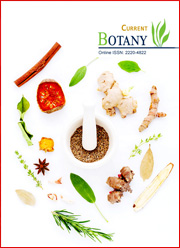Detection and Analysis of melanin pigment in the edible seed coat of some plants
DOI:
https://doi.org/10.25081/cb.2024.v15.8594Keywords:
Phytomelanin, Fabaceae, Leguminaceae, Isolation, Sesamum indicum, Vigna mungoAbstract
Melanin is a dark phenolic substance present in plants, animals, and microorganisms. The role of melanin in plants is to offer protection against biotic and abiotic conditions. The other possible functions in plants are unknown. Studying the occurrence of melanin in plants is essential to understand the taxonomic evolution of plants and its application in different fields. The deposition and distribution of Phytomelanin in the seed coat was studied using a light microscopy The seed coats of Phaselous vulgaris (Leguminaceae), Vigna mungo (Fabaceae), Linum usitatissimum (Linaceae), Cicer arietinum (Fabaceae), Vigna unguiculata (Fabaceae), Sesamum indicum (padaliaceae) and Macrotylama uniflorum (Fabaceae) showed the presence of melanin. Among the plant studied, S. indicum and V. mungo had a higher yield of melanin per 5 g of seeds. Melanin was extracted, purified and a confirmatory test was also conducted. UV and FT-IR studies were carried out with purified melanin. V. mungo and P. vulgaris showed no absorbance in the UV spectrum. The Maximum absorbance was found at 276 nm for S. indicum, M. uniflorum at 283 nm, L. usitatissimum at 276.5 nm, and V. unguiculata at 286 nm. It is evident from the study that phytomelanin is present in higher concentrations in S. indicum followed by V. mungo.
Downloads
References
Al-Tayib, O. A., El Tahir, K. E., Idriss, M. H., Eram, K. E., & Hassib, A. M. (2014). Nigella sativa L seeds melanin: A new hypoglycemic agent. Comparison with insulin in alloxan-diabetic rats. Scholars Academic Journal of Pharmacy, 3(4), 332-335.
Bazhenov, M. S., Litvinov, D. Y., Divashuk, M. G. (2023). Melanin found in wheat spike husks. Preprint BioRxiv. https://doi.org/10.1101/2023.05.30.542842
Cardinale, M., Viola, M., Miceli, E., Faddetta, T., Puglia, A. M., Maggini, V., Tani, C., Firenzuoli, F., Schiff, S., Bogani, P., Fani, R., & Papini, A. (2021). The Cypsela (Achene) of Echinacea Purpurea as a Diffusion Unit of a Community of Microorganisms. Applied Microbiology and Biotechnology, 105, 2951-2965. https://doi.org/10.1007/s00253-021-11212-2
Ceccarelli, S., Grando, S., & Van Leur, J. A. G. (1987). Genetic diversity in barley landraces from Syria and Jordan. Euphytica, 36, 389-405. https://doi.org/10.1007/BF00041482
El-Naggar, N. E.-A., & El-Ewasy, S. M. (2017). Bioproduction, characterization, anticancer and antioxidant activities of extracellular melanin pigment produced by newly isolated microbial cell factories Streptomyces glaucescens NEAE-H. Scientific Reports, 7, 42129. https://doi.org/10.1038/srep42129
Gillikin, J. W., & Graham, J. S. (1991). Purification and developmental analysis of the major anionic peroxidases from the seed coat of Glycine max. Plant Physiology, 96, 214-220. https://doi.org/10.1104/pp.96.1.214
Glagoleva, A. Y., Shoeva, O. Y., & Khlestkina, E. K. (2020). Melanin Pigment in Plants: Current Knowledge and Future Perspectives. Frontiers in Plant Science, 11, 770. https://doi.org/10.3389/fpls.2020.00770
Hou, R., Liu, X., Xiang, K., Chen, L., Wu, X., Lin, W., Zheng, M., & Fu, J. (2019). Characterization of the physicochemical properties and extraction optimization of natural melanin from Inonotus hispidus mushroom. Food Chemistry, 277, 533-542. https://doi.org/10.1016/j.foodchem.2018.11.002
Kalka, K., Mukhtar, H., Turowski-Wanke, A., & Merk, H. (2000). Biomelanin Antioxidants in Cosmetics: Assessment Based on Inhibition of Lipid Peroxidation. Skin Pharmacology and Applied Skin Physiology, 13(3-4), 143-149.
Keles, Y., & Özdemir, Ö. (2018). Extraction, purification, antioxidant properties, and stability conditions of phytomelanin pigment on the sunflower seeds. International Journal of Secondary Metabolite, 5, 140-148. https://doi.org/10.21448/ijsm.377470
Laxmi, M., Kurian, N. K., Smitha, S., & Bhat, S. G. (2016). Melanin and bacteriocin from marine bacteria inhibit biofilms of foodborne pathogens. Indian Journal of Biotechnology, 15(3), 392-399.
Marques, D., Marzinek, J., & De-Paula, O. C. (2021). A new report of phytomelanin in cypselae of Vernonieae: the case of the type species of Lychnophora Mart. Annals of the Brazilian Academy of Sciences, 93(4), e20210204. https://doi.org/10.1590/0001-3765202120210204
Pandey, A. K., Wilcox, L. W., Sack, F. D., & Stuessy, F. (1989). Development of the phytomelanin layer in fruits of Ageratum conyzoides (Compositae). American Journal of Botany, 76(5), 739-746. https://doi.org/10.1002/j.1537-2197.1989.tb11368.x
Park, K.-I., Ishikawa, N., Morita, Y. Choi, J.-D., Hoshino, A., & Iida, S. (2007). A bHLH regulatory gene in the common morning glory, Ipomoea purpurea, controls anthocyanin biosynthesis in flowers, proanthocyanidin and phytomelanin pigmentation in seeds, and seed trichome formation. Plant Journal, 49(4), 641-654. https://doi.org/10.1111/j.1365-313X.2006.02988.x
Pralea, I.-E., Moldovan, R.-C., Petrache, A.-M., Ilieș, M., Hegheș, S.-C., Ielciu, I., Nicoară, R., Moldovan, M., Ene, M., Radu, M., Uifălean, A., & Iuga, C.-A. (2019). From extraction to advanced analytical methods: the challenges of melanin analysis. International Journal of Molecular Sciences, 20(16), 3943. https://doi.org/10.3390/ijms20163943
Qi, Y., Liu, J., Liu, Y., Yan, D., Wu, H., & Li, R. (2020). Polyphenol oxidase plays a critical role in melanin formation in the fruit skin of persimmon (Diospyros kaki cv. ‘Heishi’) Food Chemistry, 330, 127253. https://doi.org/10.1016/j.foodchem.2020.127253
Roy, S., & Rhim, J. W. (2022). New Insight into Melanin for Food Packaging and Biotechnology Applications. Critical Reviews in Food Science and Nutrition, 62(17), 4629-4655, https://doi.org/10.1080/10408398.2021.1878097
Selvakumar, P., Rajasekar, S., Periasamy, K., & Raaman, N. (2008). Isolation and characterization of melanin pigment from Pleurotus cystidiosus (telomorph of Antromycopsis macrocarpa). World Journal of Microbiology and Biotechnology, 24, 2125-2131. https://doi.org/10.1007/s11274-008-9718-2
Shoeva, O. Y., Mursalimov, S. R., Gracheva, N. V., Glagoleva, A. Y., Börner, A., & Khlestkina, E. K. (2020). Melanin formation in barley grain occurs within plastids of pericarp and husk cells. Scientific Reports, 10, 179. https://doi.org/10.1038/s41598-019-56982-y
Published
How to Cite
Issue
Section
Copyright (c) 2024 Anitha Rajasekaran, Geetha Kamalakannan

This work is licensed under a Creative Commons Attribution-NonCommercial 3.0 Unported License.



 .
.